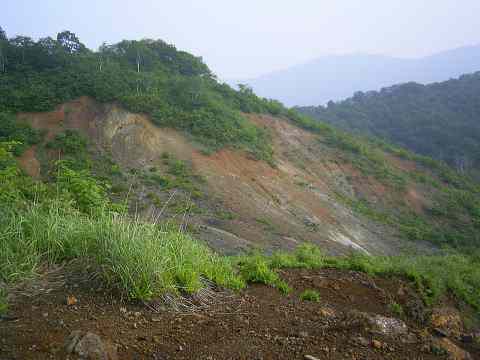Kamioka Mine
Kamioka village, Hida city, Gifu pref., Japan
Mount Ikeno, Okunoyama, Toyama city, Toyama pref., Japan
Mount Ikeno area is closed to collecting.
Occurrence
Skarn formed in limestone of the Hida metamorphic belt by contact metamorphism of the Late Triassic (220 Ma) Funatsu Granitic Rocks. The pneumatolytic deposit and moderate temperature hydrothermal deposit were formed by the early Paleocene (65 Ma) granite porphyry dikes. The limestone of the Hida metamorphic belt has been subjected to Granulite facies metamorphism as a part of the medium-P Hida metamorphism in the Late Ordovician to Carboniferous Late Pennsylvanian (450-300 Ma). Origin of hydrothermal water is meteoric water, and origin of ore minerals is Hida metamorphic rocks and Hida granitoids. The Hida metamorphic belt was formed by the collision of the Yangtze Craton with the North China Craton. The Hida metamorphic rocks had been subjected to Epidote-Amphibolite facies metamorphism in the MIddle Triassic (240 Ma), and has been subjected to Greenschist facies metamorphism by the Late Triassic (220 Ma) Funatsu Granitic Rocks. The Funatsu Granitic rocks are I-type (Magnetite-series). Less than 3 km apart from the Funatsu Granitic rocks, the heat source. The sulfide deposits are in contact with granite porphyry dikes. Metamorphic age was determined by K-Ar and Rb-Sr radiometric dating, and granitic rocks by Th-Pb and SHRIMP dating. Two types of host rocks were recognized: "Moku-ji" and "Shiro-ji". Moku-ji is mainly composed of hedenbergite and is the host of typical skarn ore, whereas Shiro-ji was formed by the middle temperature hydrothermal activity at late stage. Shiro-ji is distributed in Moku-ji as lens or vein, or directly in limestone. There are many deposits in the territory of Kamioka Mine.
Lead/Zinc deposit
>>Tochidou deposit: Composed of 50 lens shaped small deposits around Mt. Nijyugo and Mt. Suribachi. The 9th deposit is the biggest ellipsoidal deposit, and its long diameter 270 m and short diameter is 60 m. Tochidou deposit is mainly composed of Moku-ji, and partly includes Shiro-ji.
>>Mosumi deposit: The remain is utilized as Kamiokande, by which prof. Koshiba got Novel prize.
>>Maruyama deposit: Rich in garnet, and formed in higher temperature than Tochidou deposit.
>>Jyabara deposit: Rich in hedenbergite, and formed in higher temperature than Tochidou deposit.
>>Urushiyama deposit:
>>Ikenoyama deposit:
Late stage hydrothermal deposit
>>Shimonomoto deposit: Hydrothermal deposit composed of gold/silber quartz veins.

Outcrop of the oxidation zone of skarn in the Hida Metamorphic Rocks. The brown part on the outcrop is the oxidation zone of the Ikenoyama deposit.
Reported Minerals
- Gold
- Silver
- Arsenic
- Bismuth
- Graphite
- Pyrite
- Chalcopyrite
- Chalcocite
- Matildite
- Galena
- Sphalerite
- Argentite
- Arsenopyrite
- Bornite
- Molybdenite
- Polybasite
- Pyragyrite
- Stannite
- Stephanite
- Tetrahedrite
- Greenockite
- Cassiterite
- Hematite
- Ilmenite
- Cuprite
- Magnetite
- Fluorite
- Scheelite
- Kamiokite
- Titanite
- Anglesite
- Apophyllite
- Hemimorphite
- Smithsonite
- Pyromorphite
- Sauconite
- Aurichalcite
- Azurite
- Chrysocolla
- Hydrozincite
- Serpierite
- Spangolite
- Veszelyite
- Adamite
- Brochantite
- Calcite
- Cerussite
- Descloizite
- Vanadinite
- Linarite
- Malachite
- Actinolite
- Diopside
- Epidote
- Clinothulite
- Grossular
- Hedenbergite
- Ilvaite
- Undetermined species
Mineral Assemblages
- Hedenbergite - Galena - Sphalerite
- Hedenbergite - Quartz - Ilvaite
- Diopside - Plagioclase - Quartz - Titanite
- Limonite - Pyromorphite - Adamite
- Smithsonite
Details of the mine
Lead and zinc are mainly mined.
History
- Around 700: Gold nuggets from Takahara-Go in the territory of Kamioka mine were mined, and submitted to the Imperial Court.
- Around 1500: Wasabo Silver Mine was established.
- Around 1520: Mozumi Silver Mine was established.
- 1589: Mozumi deposit was found.
- 1886: Mitsui Group bought all deposit in this area and moderized as Kamioka Mine.
- 1892: Began to mine silver, copper, and lead.
- 1906: began to mine zinc.
- 1932: Maruyama deposit was found.
- 2001: The mine was closed.
Localities
- Kamioka Mine (Pb-Zn)
- Kiura Mine (Emery)
- Toroku Mine (Arsenate)
- Obira Mine (Granite porphyry)
- Hoei Mine (Granite porphyry)